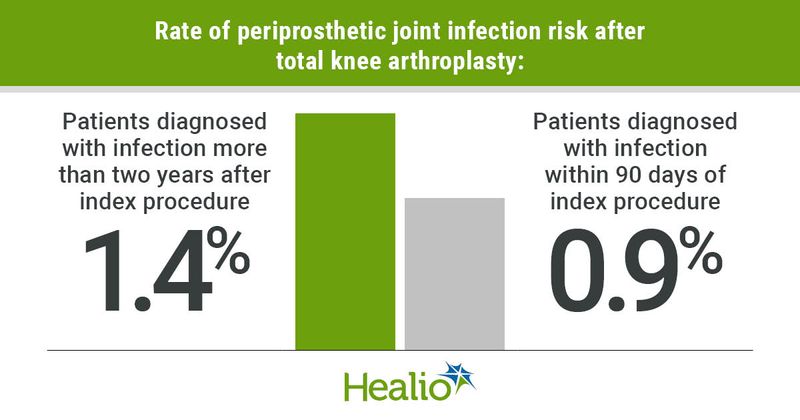Several comorbidities found to be independent risk factors for late PJI after TKA
Key takeaways:
- Researchers found a higher rate of late periprosthetic joint infection vs. early periprosthetic joint infection.
- Chronic kidney disease was the strongest risk factor for late infection.
GRAPEVINE, Texas — Results presented here showed several comorbidities were independent risk factors for development of late periprosthetic joint infection after total knee arthroplasty.
“In conclusion, risk factors for late PJI include diabetes, chronic kidney disease, malignancy, rheumatoid arthritis and hypertension, with the common denominator being a chronic and weakened immune system,” George N. Guild III, MD, said during his presentation at the American Association of Hip and Knee Surgeons Annual Meeting.

To identify comorbidities associated with late vs. early PJI in patients undergoing primary TKA, Guild and colleagues analyzed data from 72,659 patients undergoing primary TKA in the IBM MarketScan database from 2009 to 2021. Early PJI was defined as infections diagnosed within 90 days of index procedure, while late PJI was defined as infection diagnosed more than 2 years after index procedure.

“There were two control groups as well: non-infected total knees early and late,” Guild said. “And we did a 1:4 propensity score matching, as well as a logistic regression, comparing 14 comorbidities between groups.”
Guild said there was a higher rate of late PJI vs. early PJI (1.4% vs. 0.9%). He also noted that, on average, patients with late PJI tended to be younger than patients with early PJI. In terms of risk factors and comorbidities for late PJI, Guild said chronic kidney disease, malignancy, diabetes, hypertension and RA were associated with developing a late PJI.
“If you look at diabetes being associated with early and late PJI, we know that chronically elevated glucose contributes to immune dysfunction, and chronic immune dysfunction is the common denominator between comorbidities that develop a late PJI,” Guild said. “Glucose control is important for long-term success in these patients and, after 90 days, their infection risk does not go away. It can be a lifelong treatment for these patients to control their sugar.”
Guild said chronic kidney disease was the strongest risk factor for late PJI.
“There is potential for perioperative counseling and optimization of chronic disease management to decrease the risk of PJI in the late stages, with the goal of long-term success,” Guild said.

